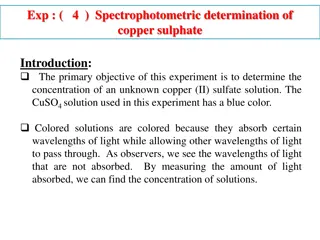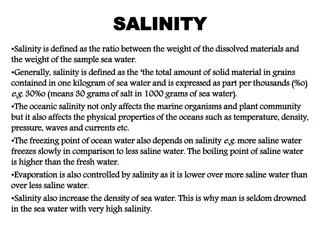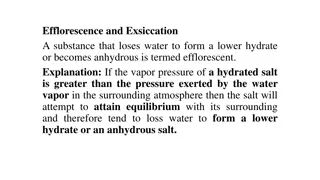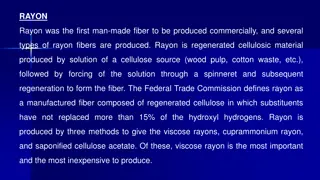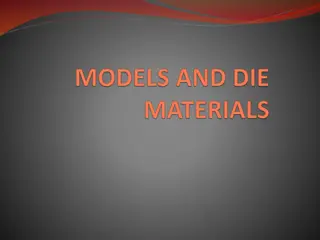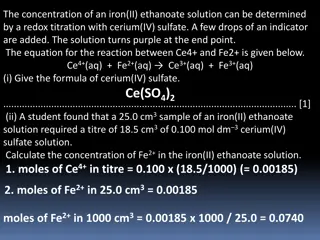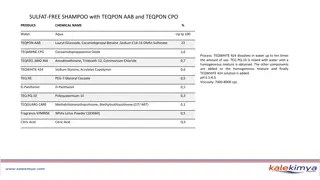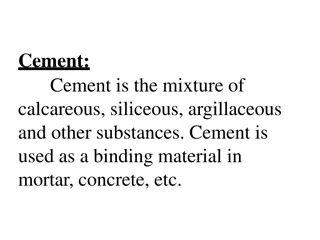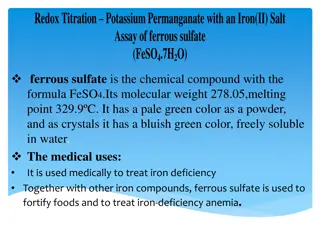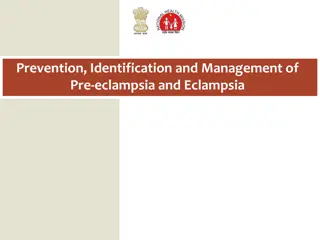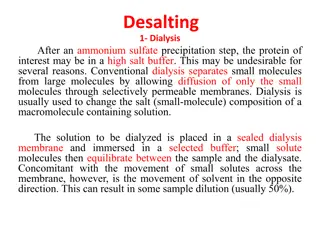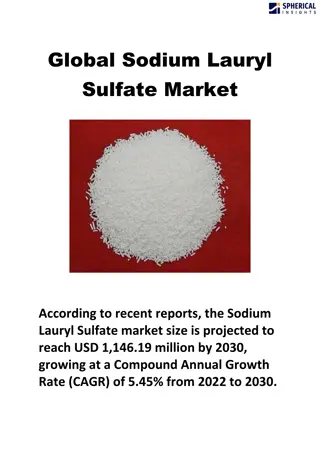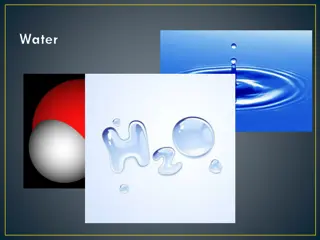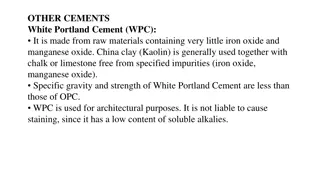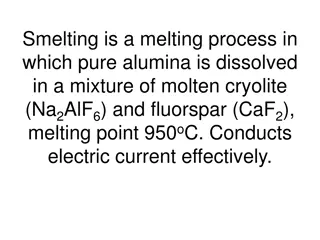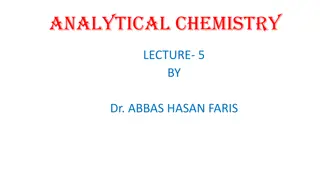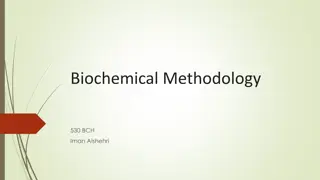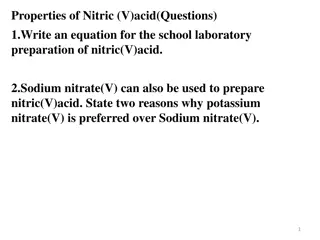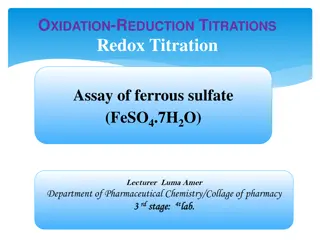Titration Colour Changes
This collection features various experiments in chemistry involving titration and solutions. It includes procedures such as standardizing hydrochloric acid using sodium carbonate, titrating hydrochloric acid with sodium hydroxide to produce sodium chloride, determining the concentration of ethanoic
0 views • 10 slides
Spectrophotometric Determination of Copper Sulfate Concentration
The experiment aims to determine the concentration of an unknown copper (II) sulfate solution by measuring light absorption at different wavelengths. Colored solutions absorb specific light wavelengths and appear colored to our eyes. By creating a calibration curve and following Beer's Law, the conc
3 views • 8 slides
Overview of Herbicides Classification and Groups
Herbicides are classified based on their chemical nature into inorganic and organic types. Inorganic herbicides, such as arsenic acid and copper sulfate, do not contain carbon atoms, while organic herbicides, like glyphosate and 2,4-D, contain carbon atoms. The classification includes various groups
4 views • 15 slides
Iron Ferrous Sulfate Market Size, Worth, Overview, Scope & Analysis to 2022-2029
Adroit Market Research has included the Global Iron Ferrous Sulfate Market\u00a0research to its database in order to provide a thorough analysis of the variables driving a general market growth trend. The study contains a lot of information and is a useful tool for professionals in the field.
0 views • 5 slides
Understanding Salinity in Seawater and Its Impacts
Salinity is the ratio of dissolved materials to the weight of seawater, affecting marine life and physical ocean properties like temperature, density, and waves. It influences freezing and boiling points, evaporation, and water density. Seawater composition includes salts like sodium chloride, magne
0 views • 11 slides
Efflorescence and Exsiccation in Chemistry
Efflorescence refers to the process where a substance loses water to form a lower hydrate or becomes anhydrous due to differences in vapor pressures. Hydrates with vapor pressures greater than the atmosphere tend to exhibit efflorescence. The rate of efflorescence increases with temperature. Exsicca
0 views • 103 slides
Overview of Rayon: Production, Properties, and Applications
Rayon, the first man-made fiber commercially produced, is a regenerated cellulosic material manufactured from wood pulp or cotton waste. Viscose rayon, the most common type, is produced through processes like the viscose method. Additives such as titanium dioxide, sodium sulfate, zinc sulfate, and g
0 views • 18 slides
Pediatric Dosage Calculations: Safe Medication Administration Guidelines
Learn how to calculate safe pediatric dosages for common medications such as Acetaminophen, Augmentin, Amoxicillin, and Ferrous Sulfate. Follow step-by-step instructions to determine the correct amount of medication to administer based on a child's weight and prescribed dosage. Ensure accuracy in do
1 views • 5 slides
Understanding Gypsum Products in Dentistry
Gypsum products play a crucial role in dentistry, serving as impression materials, die materials, and models. The classification of gypsum products includes impression plaster, model plaster, dental stone, and high-strength variations. The manufacturing process varies for dental plaster and stone, w
2 views • 41 slides
Chemical Analysis and Redox Reactions in Chemistry
Iron(II) ethanoate concentration determination using redox titration with cerium(IV) sulfate, balanced redox equations for manganate(VII) ion oxidizing iron(II) ion, and calculations of iron percentage in samples using titration with potassium manganate(VII). Molarities and concentrations are calcul
1 views • 6 slides
Understanding Redox Reactions in Chemistry
Salts can be prepared through redox reactions involving metals and acids. This interactive lesson covers oxidation numbers, identifying oxidized and reduced elements, and explaining electron transfer in redox reactions. Examples include reactions of aluminum with sulfuric acid and magnesium with cop
2 views • 12 slides
Premium Sulfate-Free Personal Care Products with Teqpon
Discover a range of premium sulfate-free personal care products featuring Teqpon technology. From a gentle sulfate-free shampoo to a versatile nonionic fabric softener, each product is meticulously formulated with high-quality ingredients to cater to different personal care needs. The Teqpon technol
3 views • 8 slides
Back Titration in Analytical Chemistry
Back titration is a technique used in analytical chemistry to determine the concentration of an analyte by reacting it with an excess of another reagent first, followed by titration of the excess reactant. This method is especially useful in cases where direct titration endpoints are difficult to di
2 views • 14 slides
Overview of Cement: Types, Composition, and Functions
Cement is a vital building material consisting of various compounds like lime, silica, and alumina. It is used in mortar and concrete. The chemical composition of cement includes elements like iron oxide and gypsum. Different types of cement serve specific purposes such as rapid hardening or sulfate
0 views • 29 slides
Redox Titration: Potassium Permanganate with Iron(II) Salt Assay
Ferrous sulfate (FeSO4.7H2O) is used in medical treatments for iron deficiency. This article discusses the redox titration process involving potassium permanganate and ferrous sulfate, along with the chemical principles, procedure, and calculations involved. Potassium permanganate is a powerful oxid
5 views • 7 slides
Clinical Audit Results of Moderate to Acute Severe Asthma in EDs 2016/17
This clinical audit presentation showcases the national results of how Emergency Departments (EDs) are performing against the established audit standards for moderate to acute severe asthma in the year 2016/17. The objectives of the audit were to benchmark current performance, enable national and pe
1 views • 36 slides
Understanding Pre-eclampsia and Eclampsia: Prevention and Management
Learn about the prevention, identification, and management of pre-eclampsia and eclampsia, which are significant causes of maternal mortality globally. This session covers definitions of hypertensive disorders of pregnancy, supportive care for women with eclampsia, and the administration of injectio
3 views • 15 slides
Protein Desalting Techniques for Biochemical Purification
Protein desalting is crucial for purifying proteins after an ammonium sulfate precipitation step, which may leave the protein in a high-salt buffer. Three common desalting methods include dialysis using semi-permeable membranes, gel filtration with Sephadex G25 to exclude salts, and ultrafiltration
4 views • 6 slides
Understanding PM2.5 in Korea and China Through Integrated Modeling and Analysis
Improved understanding of PM2.5 in Korea and China is achieved through integrated modeling of satellite, aircraft, and surface observations. Studies show fast oxidation of SO2 to sulfate PM during winter haze events, with correlations of sulfate with nitrogen oxides explained in-depth. The persisten
0 views • 13 slides
Understanding Fly Ash in Coal-Fired Power Plants
Fly ash is a by-product material generated from coal combustion in power plants. It is a waste material that needs proper disposal or recycling. The chemical composition of fly ash includes Silicon Dioxide, Calcium Oxide, Iron Oxide, and Aluminum Oxide, among others. ASTM C618 defines two classes of
0 views • 30 slides
Exploring Copper Sulfate, Sodium Nitrate, and Ammonium Chloride in Chemistry Projects
Delve into the properties and uses of copper sulfate, sodium nitrate, and ammonium chloride in chemistry projects. Discover how these chemical compounds play vital roles in agriculture, industry, and everyday applications, from fungicides to food additives.
0 views • 9 slides
Understanding Chemical Bonding: Valency, Formulas, and Reactions
Explore the world of chemical bonding with this unit covering valencies, chemical formulas, ionic vs. covalent bonds, and exothermic vs. endothermic reactions. Learn to predict element combinations, create molecular formulas, and differentiate between various bond types. Jigsaw diagrams demonstrate
0 views • 46 slides
Exploring Chemical Substances: Dissolved in Water
This article delves into the properties of various chemical substances when dissolved in water, including Calcium Carbonate, Sodium Carbonate, Iron Oxide, Magnesium Sulfate, and Potassium Chloride. It discusses the exothermic and endothermic reactions that occur during dissolution, along with the ch
0 views • 6 slides
Advanced Biomarker Analysis in Biogeochemistry Studies
In biogeochemistry research, advanced analytical techniques are utilized to isolate and separate organic matter, focusing on major carbon pools in bodies of water like Lake Superior. Biomarkers such as fatty acids and specific compounds are identified as indicators for various microbial processes, i
0 views • 11 slides
Understanding Chemical Formulas and Subscripts in Chemistry
Chemical formulas and subscripts are fundamental concepts in chemistry for expressing the composition of substances at the molecular level. This article explores the significance of chemical formulas in representing elements and compounds like water (H2O), carbon dioxide (CO2), sodium chloride (NaCl
0 views • 37 slides
Understanding Different Types of Cement for Construction
Cement is a crucial component in concrete and mortar, with various types available based on specific project requirements. Types include Ordinary Portland Cement for general construction, Modified Portland Cement for sulfate resistance, High Early Strength Cement for quick setting, Low Heat Portland
0 views • 5 slides
Understanding Different Types of Cement
White Portland Cement (WPC) is ideal for architectural use due to its low iron and manganese oxide content, while High Alumina Cement (HAC) offers rapid hardening and sulfate resistance. Portland Pozzolan Cement provides greater sulfate attack resistance and is suitable for marine and hydraulic cons
0 views • 5 slides
Metal Smelting and Electrorefining Techniques Explained
Smelting is a process involving the dissolution of pure alumina in a molten mixture of cryolite and fluorspar to extract metals like aluminum. Electrolysis is used to separate the metals where oxygen is liberated at the anode and the metal is deposited at the cathode. This process is illustrated wit
0 views • 29 slides
Understanding Oxidation-Reduction Reactions in Analytical Chemistry
Oxidation-reduction reactions play a crucial role in various chemical processes, including photosynthesis and corrosion. This content delves into the basics of redox reactions, explaining how electrons are transferred between reactants, leading to changes in oxidation numbers. Examples such as the r
0 views • 10 slides
Understanding Water Composition for Brewing Beer
The minerals and salts in brewing water significantly impact pH levels, particularly in all-grain brewing, affecting flavor contribution. Maintaining ideal mash pH and alkalinity is crucial for enzymatic activity during the brewing process. Alkalinity helps neutralize acids and influences various re
0 views • 16 slides
Understanding North Atlantic Hurricane Drought and Aerosol Impact
This study explores the influence of sulfate aerosols on the late 20th-century North Atlantic Hurricane drought, focusing on the interaction of European sulfate aerosols and African dust. It investigates the radiative forcing effects and variability in hurricane activity, proposing hypotheses relate
0 views • 17 slides
Biochemical Methodology 530 - Lactate Dehydrogenase Extraction and Purification Experiment
This course focuses on the extraction and purification of lactate dehydrogenase (LDH) using a series of procedures involving tissue preparation, centrifugation, and ammonium sulfate precipitation. The methodology includes detailed steps from preparing the extraction buffer to isolating LDH in differ
0 views • 10 slides
Exploring Color Combinations with Chemical Reactions
Explore various color combinations using aqueous solutions of potassium dichromate, copper sulfate, and other colorless solutions. By mixing these solutions, generate distinct colors in test tubes through chemical reactions. Different hues such as yellow, blue, orange, light purple, and green are ac
0 views • 6 slides
Protein Purification Techniques and Ammonium Sulfate Precipitation
Protein purification is a crucial process in biotechnology to isolate specific proteins from complex mixtures. Techniques such as exploiting physio-chemical properties, binding affinity tags, and biological activity are used. Ammonium sulfate precipitation, a common first step, involves adding incre
0 views • 60 slides
Laboratory Preparation of Nitric(V) Acid & Chemical Reactions
In this set of questions, we explore the preparation of nitric(V) acid in a school laboratory setting, its properties, and chemical reactions. Topics covered include the use of sodium nitrate(V) and potassium nitrate(V), the use of glass apparatus during the preparation process, color changes in con
0 views • 4 slides
Protecting Wild Rice in Minnesota: Sulfate Standards and Environmental Preservation
Understanding the importance of safeguarding wild rice in Minnesota due to its cultural, spiritual, and economic significance along with its sensitivity to sulfate pollution. Exploring sources of sulfate, the sulfate-sulfide relationship, and proposed solutions for maintaining wild rice populations.
0 views • 10 slides
Understanding Status Asthmaticus: Diagnosis and Treatment Considerations
Status Asthmaticus is a severe asthma exacerbation that requires immediate medical attention. Recognizing the symptoms, associated diagnoses, and appropriate treatment plans, such as continuous albuterol and IV corticosteroids, is crucial. Failure to respond to standard at-home treatments like albut
0 views • 13 slides
Understanding Lock-Free and Wait-Free Algorithms in Concurrent Data Structures
Illustration of lock-free and wait-free algorithms compared to blocking algorithms, with insights on concurrent object execution, blocking vs. non-blocking algorithms, definitions, comparisons between locks, lock-free, and wait-free approaches, and explanations on making algorithms wait-free. Exampl
0 views • 23 slides
Assay of Ferrous Sulfate (FeSO4.7H2O) by Redox Titration Experiment
This experiment involves determining the weight and weight percentage of an unknown sample of FeSO4.7H2O through a redox titration using potassium permanganate solution. Ferrous sulfate, a chemical compound used in medical treatments, is oxidized to ferric sulfate in the presence of sulfuric acid. T
0 views • 9 slides

